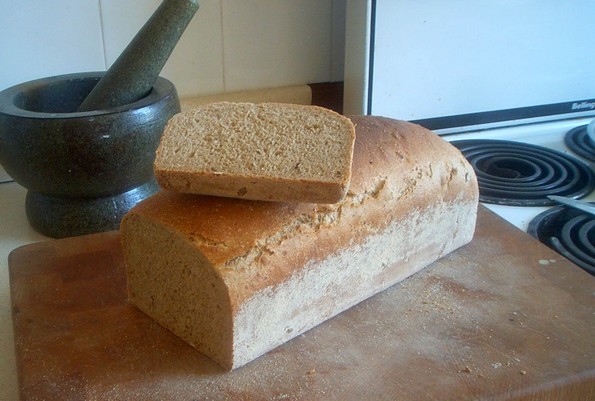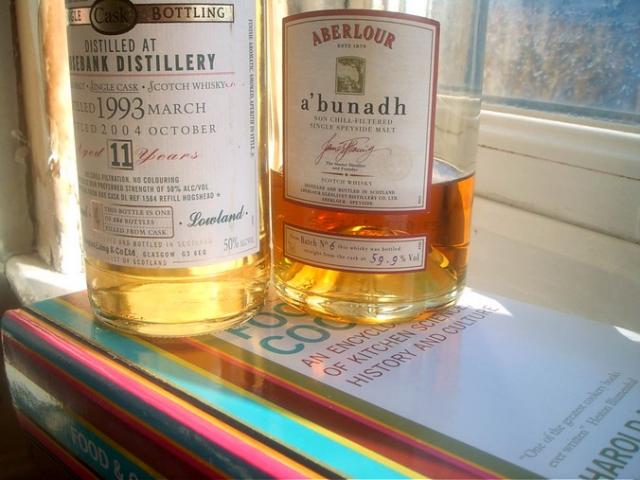-
Posts
857 -
Joined
-
Last visited
Content Type
Profiles
Forums
Store
Help Articles
Posts posted by culinary bear
-
-
One commis at work tried that with very hard white flour, and I swear you could have used the resulting bread as artillery shells. I've seen it used for wholemeal with decent results.
The Guinness loaf turned out decently, considering the oven :

BFT 55 minutes, final prove 25 mins, oven 210C for 45 minutes with steam for first five.
-
'93 Rosebank and Aberlour a'bunadh. I remember a nice Glenfarclas at 105 Proof, too.

-
I always add the liqueur to the cream used to make the ganache (1350g couverture, 1100g 48% cream, 150g liqueur). I've never had a problem with the ganache seizing when done like this, so it's a pretty foolproof method.
-
Jackal10's right, in the olden days competition loaves were routinely put through a mangle as often as twenty times to completly break down air pockets before the final prove giving as even a crumb structure as possible.
From my own experience relatively high-hydration wholewheat doughs are very prone to overmixing, as well as overproving. In overmixed batter goods you often see a 'tunneling' effect similar to what you describe.
Have another go and let us know what happens.
I'm making guinness and onion bread today in the worst oven in the world. Wish me luck...
-
What? The heat loss is exactly the same (assuming no significant conductive loss, using the same pan blah blah). If you have 1Kg of vegtables with a thermal capacity close to water at 20C, then you need ~80 KCalories of heat to bring it up to 100C. It doesnt matter if you have 1L of water or 1000L, you still need a way to push in 80 KCals of heat and the only way is with the burner.
I should have phrased that better.
The amount of heat lost is, of course, the same. The temperature drop is significantly reduced by having a larger amount of water, because that same 80 kCal of energy lost is dissipated through a larger volume of (already boiling) water.
-
Lemon Curd?
Great on toast for breakfast, used as a crepe filling, stirred into ice cream, used to make an iced parfait, added to a sauce anglaise to go with steamed puddings... I could go on...
Or, I have a really good recipe for a whole lemon and almond sponge, which involves boiling the lemons whole until soft, pureeing and sieving them before making your batter.
The extra flavour and bite from really good organic lemons would come out well in either.
-
Beetroot make damned fine crisps.
-
Wow, not a lot of condensed milk users here. Throwing it away?! Oxidation and chemical spoilage?!
Condensed milk, depending on the conditions under which is was made/stored, can vary from pure white to dark tan.
About every 4th can I buy is tan and I almost never get one that's pure white. I've just come to accept condensed milk to be light beige. The white is more preferable, but the caramel notes from the tan version can be nice, depending on the dessert.
It is what it is. But please, don't throw it away.
I have never, in my life, opened a can of sweetened condensed milk to find it anything other than white and normal. Given years of experience as a pastry chef (not to mention as a sweet-toothed civilian), that's an awful lot of cans, usually of Nestle or Fussel's brand.
Is this more a US thing?
-
The amount of water has not much to do with recovery time. Your still sucking the same amount of heat out of the water that you need to put back in. Instead, the problem lies with a wimpy burner.
No, that's wrong. The thermal energy loss is the same, yes, but the reservoir of heat (the body of water) is much larger when you use a bigger pot, and it is the amount of water you use which determines the initial amount of heat loss when you add your vegetables; the burner is a factor only in getting the temperature back up to the boiling point.
What more water does is that minimises the temperature drop. As long as the temperature stays above 70C or so, your vegtables should be fine so theres no need to worry if the water is merely not boiling. If you are really worried, keep a probe thermometer in the water but I doubt a few florets are going to do anything much.Blanching anywhere near 80C, never mind 70C, is going to give you limp, colourless, dull and lifeless vegetables.
Salt your water, more than you think you'll need to. It should taste as salty as seawater. This, as well as seasoning the vegetables, helps reduce colour loss and is especially important when blanching green vegetables.
Keller may be anally retentive, but he happens to be right.
-
I've always had a passing fondness for Terry Durack too, ever since I read his contribution to Conran's "Restaurants".
It's a guide to restauranteurs on how to get a good review. I got to the stage of 'ow, it hurts to laugh this much'.
A question, apropos regionality:
Do the better critics tend to be London based? Mainly SE England?
-
The second one does sound a bit unusual.
From a 'making guests ill' perspective, it's unlikely to be anything bacteriological, as the high sugar content makes it unlikely that harmful bacteria would flourish in such an environment.
Two things I can think of :
1) The seal of the can has been compromised and led to oxidation and chemical spoilage, perhaps as a result of exposure to untinned metal.
2) It's a manufacturing fault and left the factory in the same state in which you opened it.
If the texture and colour were uniform throughout, I'd imagine it would be much more likely to be 2).
No guarantees as to your guests' wellbeing, but I would imagine that if you haven't had any consequences after your tasting of the dessert, it's unlikely to be a problem.
-
"Restaurant" magazine has a section where the relative contents of reviewers' articles are displayed graphically; the food, the restaurant, other restaurants, waffle etc. It's a curious gimmick, but educational.
Unsurprisingly, Giles "I'm on TV now" Coren, AA "Purveyor of horrible suburbanite fiction" Gill and Michael "pass me that syringe full of spunk please chef, that annoying bastard Winner's in for lunch and I can't get wood" Winner tend to have more waffle than the others.
-
Anybody got any idea when 'hospitality' became an 'industry'?
Roughly about the time John Fothergill died.
-
I thought "porridge oats" might mean rolled oats, and, as I suspected that rolled oats wouldn't do in parkin, I instead used some finer-than-pinhead steel-cut oats. I was afraid pinhead oats would stay too hard, as the batter wasn't very wet. Anyhow, my parkin turned out really well. I should have hidden it, though, as it got eatten up before it had a chance to improve with age.
Sensible choice of oat. You do need to hide it; wrap it in baking parchment and put it in a tin, then bury it in the back garden if you need to! Matured parkin is truly a thing of joy (as is soft gingerbread - I used to make mine a fortnight in advance of needing it)
I thought "1lb loaf tins" and 2lb loaf tins" were some standard sizes--it seems like all my English recipes that require bread or cake to be baked in a loaf tin refer to them that way.Unfortunately not... Reaching for my copy of Elizabeth David's "English Bread and Yeast Cookery" I find her quoting Walter Banfield, writing in the 1930s, that "the square 2lb tin alone can be purchased in about a hundred different sizes".
-
Porridge oats are usually rolled, which makes them look rather like small Kellogg's cornflakes.
For making porridge, some people use rolled oats, some use jumbo oats (which are rolled oats but bigger), some use pinhead oatmeal (the particles of which are about the same size as couscous grains) and others use the steel-cut oats you describe above (and which seem to be the choice in most of the US). This is a long-winded way of saying that there is no such thing as a definable 'porridge oat' as far as size and milling goes.
For parkin, one of the loveliest sticky confections ever to be conjured up ever, I'd use pinhead oatmeal. If this can't be found, then blitz steel-cut oatmeal in a food processor until it gets more finely milled. Rolled oats in parkin would be a heinous crime. When you make parkin, by the way, always try and keep it for a week before you eat it; it gets more sticky and moist and matures beautifully.
As for cake tins, it varies according to what you're going to bake. There are literally hundreds of different sizes that people use. When you say 'a 1lb loaf tin', is that for 1lb of bread dough, or 1lb of finished bread? Or do you mean for a product other than bread?
-
That doesn't bode well for those of us who work 15 hour days!

-
Happily, Fraiche has been awarded a one-star "rising star" in the 2006 Michelin Guide.
-
Mixed feelings...
+ve
... We kept our star.
... Fraiche is on its way to a star, thoroughly deserved.
-ve
... Winteringham Fields down to one, which is bound to be a kick in the teeth for Robert.
... Watersreach in Manchester lost their Bib...
-
1) They paint themselves yellow.
2) There are footprints in the butter.
3) So they can hide in cherry trees.

-
1500g milk
185g short-grain rice (carolina rice, or rice suitable for risotto)
215g sugar
6 whole eggs, 4 yolks.
Cook rice in milk until tender. Mix eggs and sugar together, and while the rice is at a roaring boil, stir the egg and sugar mix in. Mix with a wooden spoon on a medium heat until thickened. Let down with double cream until you get the consistency you want. If wanted, you can then put it in a casserole, dot the top with butter, and cook in the oven until a skin forms.
-
I was just talking to Gary the other day about weight loss in the catering profession... I've lost 1st 10lb (about 10kg) in the last two months after starting a 70 hour a week job, and while it might be welcome, it's a little frightening...!
-
fantastic lifestyle opportunity... ha ha ha...

-
Certainly.
If you happen to come by any, please send my share to :
The St Eustace Home for Terminally Weary Culinarians,
Rockall,
UK.
-
It's worth mentioning that the guest evenings at Northcote for this year's festival are fully booked up now...



Bruichladdich's 92% abv Whiskey
in Spirits & Cocktails
Posted
It's a lovely whisky, and reminds me of Brora quite a bit. Sadly Brora is now mothballed with little hope of re-opening.
Interesting that mine is 0.1% stronger than yours, probably a different cask.
Most new-run spirit (straight out of the still) is diluted with a small proportion of water before being used to fill the cask. Once matured, it's cut down again before bottling (this step is usually skipped in 'cask-strength' whiskies).
As it matures in cask, whisky loses strength as the alcohol evaporates quicker than the water, so this one will have to be distilled with an initial alcohol content well above the final 92%. How much of the character of the whisky is going to be left behind in the still?